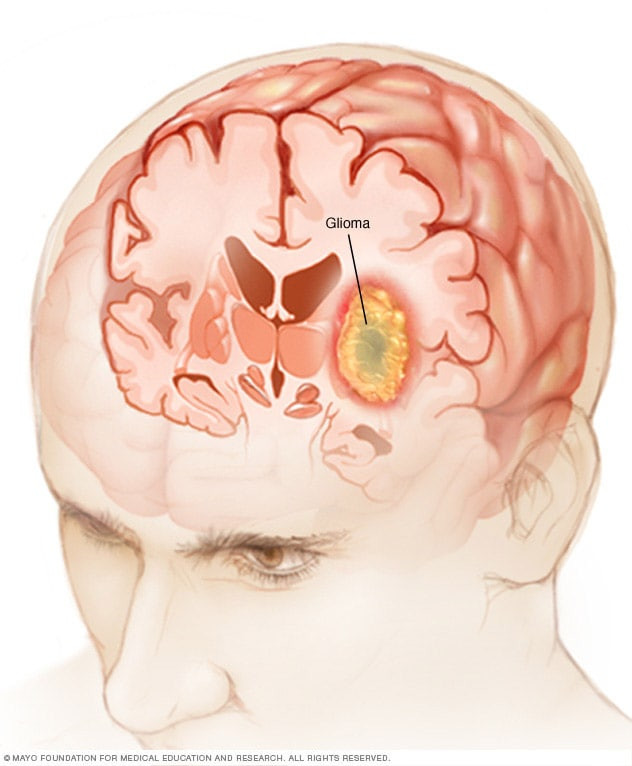Definisi
Hidrosefalus adalah penumpukan cairan di dalam ventrikel atau rongga otak. Cairan ini adalah cairan serebrospinal, yaitu cairan pelindung otak dan tulang belakang. Kelebihan cairan akan memperlebar ventrikel dan memberi tekanan pada otak. Cairan serebrospinal normalnya mengalir melalui ventrikel menuju ke ruang di sekitar otak dan tulang belakang. Tekanan cairan yang terlalu banyak dapat merusak jaringan otak dan menyebabkan berbagai masalah fungsi otak.
Hidrosefalus dapat terjadi pada semua usia, namun lebih sering terjadi pada bayi dan usia 60 tahun ke atas. Operasi pada hidrosefalus dapat mengembalikan dan mempertahankan kadar normal cairan serebrospinal di otak. Terapi lain juga kadang diperlukan untuk mengatasi gejala atau masalah lain akibat hidrosefalus.
Penyebab
Hidrosefalus disebabkan oleh ketidakseimbangan antara cairan serebrospinal yang diproduksi dan yang diserap ke dalam aliran darah. Cairan serebrospinal diproduksi oleh jaringan yang melapisi ventrikel otak lalu mengalir melalui saluran menuju ke ruang di sekitar otak dan tulang belakang. Cairan ini akan diserap oleh pembuluh darah di permukaan lapisan otak. Cairan serebrospinal berperan penting bagi otak untuk:
- Menjaga otak yang relatif berat agar tetap mengapung di dalam tengkorak
- Sebagai bantalan otak untuk mencegah cedera
- Mengeluarkan produk sisa metabolisme otak
- Mempertahankan tekanan di dalam otak sebagai kompensasi perubahan tekanan darah di otak
Kelebihan cairan serebrospinal di ventrikel dapat terjadi karena:
- Obstruksi atau sumbatan. Sumbatan yang paling umum adalah sumbatan parsial atau sebagian, baik dari satu ventrikel ke ventrikel lain atau dari ventrikel ke ruang lain di sekitar otak.
- Penyerapan yang buruk. Penyebab ini lebih jarang terjadi. Hal ini sering dikaitkan dengan peradangan jaringan otak akibat penyakit atau cedera.
- Produksi cairan berlebih. Dalam hal ini, cairan serebrospinal dibuat lebih cepat daripada proses penyerapannya. Penyebab ini juga jarang terjadi.
Hidrosefalus ada yang bersifat kongenital, yaitu dibawa sejak lahir, dan ada yang di dapat setelah dewasa. Pada hidrosefalus kongenital, penyebabnya antara lain karena:
- Abnormalitas genetik (kelainan pada gen)
- Gangguan perkembangan pada otak, tulang belakang, atau sumsum tulang belakang, seperti spina bifida (sumsum tulang belakang gagal berkembang)
- Komplikasi kelahiran prematur seperti perdarahan pada ventrikel/rongga otak
- Infeksi pada masa kehamilan seperti mumps atau rubella (campak Jerman)
Sementara pada hidrosefalus yang didapat, penyebabnya antara lain:
- Tumor otak atau tulang belakang
- Infeksi pada sistem saraf pusat (otak atau tulang belakang)
- Cedera kepala atau stroke yang menyebabkan perdarahan otak
Faktor Risiko
Pada banyak kasus, penyebab hidrosefalus tidak diketahui. Namun, beberapa masalah perkembangan atau masalah medis dapat berperan pada kejadian hidrosefalus.
Hidrosefalus bawaan yang sudah ada sejak lahir atau muncul segera setelah lahir dapat terjadi karena beberapa hal berikut:
- Perkembangan tidak normal sistem saraf pusat yang dapat menyumbat aliran cairan serebrospinal
- Perdarahan di dalam ventrikel, kemungkinan komplikasi pada kelahiran prematur
- Infeksi di rahim seperti rubella atau sifilis selama kehamilan, yang dapat menyebabkan peradangan pada jaringan otak janin
Faktor lain yang berperan pada semua kelompok usia meliputi:
- Tumor otak atau sumsum tulang belakang
- Infeksi sistem saraf pusat, seperti meningitis bakteri
- Pendarahan di otak akibat stroke atau cedera kepala
- Cedera otak traumatik lainnya
Gejala
Tanda dan gejala hidrosefalus bervariasi berdasarkan usia saat muncul gejala.
Bayi
Tanda dan gejala umum hidrosefalus pada bayi meliputi:
- Ukuran kepala lebih besar secara tidak normal
- Peningkatan pesat ukuran kepala
- Ubun-ubun menonjol atau tegang di bagian atas kepala
- Mual dan muntah
- Mengantuk atau lesu
- Rewel
- Nafsu makan menurun atau tidak mau minum susu
Balita dan anak yang lebih besar
Gejala yang mungkin terjadi antara lain:
- Sakit kepala
- Penglihatan kabur atau ganda
- Pembesaran tidak normal kepala balita
- Mengantuk atau lesu
- Mual atau muntah
- Gangguan keseimbangan
- Koordinasi gerak yang buruk
- Perubahan kepribadian
- Penurunan prestasi belajar
- Keterlambatan atau gangguan pada keterampilan yang sudah dikuasai sebelumnya, seperti berjalan atau berbicara
Dewasa muda dan tengah baya
Tanda dan gejala yang umum pada kelompok usia ini meliputi:
- Sakit kepala
- Kehilangan koordinasi atau keseimbangan
- Kehilangan kontrol kandung kemih atau sering ingin buang air kecil
- Masalah penglihatan
- Penurunan daya ingat, konsentrasi, dan keterampilan berpikir lain yang dapat mempengaruhi kinerja
Orang tua
Pada orang tua, tanda dan gejala hidrosefalus yang umum ditemukan adalah:
- Kehilangan kontrol kandung kemih atau sering ingin buang air kecil
- Hilang ingatan
- Hilangnya kemampuan berpikir atau penalaran lainnya secara progresif
- Kesulitan berjalan, sering digambarkan sebagai gaya berjalan terseok-seok
- Koordinasi atau keseimbangan yang buruk
Diagnosis
Diagnosis hidrosefalus dapat ditentukan melalui:
- Informasi tanda dan gejala yang dialami pasien
- Pemeriksaan fisik umum
- Pemeriksaan neurologis atau saraf
- Pemeriksaan radiologi otak
Pemeriksaan neurologis
Jenis pemeriksaan neurologis tergantung pada usia pasien. Dokter saraf akan mengajukan pertanyaan dan melakukan tes yang relatif sederhana untuk menilai kondisi otot, gerakan, dan seberapa baik indra Anda berfungsi.
Pencitraan otak
Tes pencitraan yang dapat membantu mendiagnosis hidrosefalus dan mengidentifikasi penyebab meliputi:
- Ultrasonografi (USG). Tes ini sering digunakan untuk penilaian awal pada bayi karena prosedurnya relatif sederhana dan berisiko rendah. USG juga dapat mendeteksi hidrosefalus sebelum lahir saat pemeriksaan kehamilan rutin.
- Magnetic Resonance Imaging (MRI). Tes ini menggunakan gelombang radio dan medan magnet untuk menghasilkan gambar otak yang detail. Pemeriksaan ini dapat memperlihatkan pembesaran ventrikel yang disebabkan oleh kelebihan cairan serebrospinal serta mengidentifikasi penyebab hidrosefalus atau kondisi lain yang berhubungan dengan gejala. Anak-anak mungkin memerlukan sedasi (obat penenang) ringan pada pemeriksaan ini. Namun, beberapa rumah sakit telah menggunakan MRI versi cepat yang umumnya tidak memerlukan sedasi.
- CT-scan. Pemeriksaan ini menggunakan sinar-X, tidak menyakitkan dan cepat. Namun, pasien harus dalam posisi diam berbaring. Sehingga, terkadang pasien anak memerlukan obat penenang ringan. Pemeriksaan ini menghasilkan gambar yang kurang detail dibandingkan MRI dan menyebabkan paparan radiasi dalam jumlah kecil. CT scan untuk hidrosefalus biasanya hanya digunakan untuk pemeriksaan darurat.
Tata Laksana
Salah satu dari dua jenis operasi berikut dapat digunakan untuk mengobati hidrosefalus.
Pembuatan sistem drainase cairan otak (shunt)
Tindakan yang paling sering dilakukan adalah pembuatan sistem drainase cairan otak (shunt). Shunt ini terdiri dari tabung panjang dan lentur yang memiliki katup untuk menjaga cairan dari otak mengalir ke arah yang benar dan dengan kecepatan yang tepat. Salah satu ujung pipa biasanya ditempatkan di salah satu ventrikel otak. Pipa kemudian disalurkan di bawah kulit di bagian tubuh lain seperti perut atau ruang jantung. Kelebihan cairan akan lebih mudah diserap pada ruang tersebut. Orang dengan hidrosefalus biasanya memerlukan sistem shunt seumur hidup dan harus dipantau rutin.
Ventrikulostomi dengan endoskopi
Ventrikulostomi adalah membuat lubang tambahan pada ventrikel. Dokter bedah akan menggunakan kamera video kecil untuk melihat ke dalam otak. Dokter akan membuat lubang di bagian bawah salah satu ventrikel atau di antara ventrikel sebagai jalur cairan serebrospinal mengalir keluar dari otak.
Komplikasi Pembedahan
Kedua prosedur pembedahan tersebut dapat menimbulkan komplikasi. Sistem shunt dapat menyebabkan gangguan pengaturan sistem drainase karena masalah mekanik, penyumbatan, atau infeksi. Sementara komplikasi ventrikulostomi meliputi perdarahan dan infeksi. Setiap kegagalan memerlukan penanganan segera, operasi perbaikan, atau penanganan lainnya. Jika muncul demam atau kambuhnya gejala awal hidrosefalus, Anda harus segera memeriksakan diri ke dokter.
Pengobatan Lainnya
Sebagian orang dengan hidrosefalus, terutama anak-anak, mungkin memerlukan perawatan tambahan, tergantung pada tingkat keparahan komplikasi jangka panjang yang terjadi. Tim perawatan anak dengan hidrosefalus dapat terdiri dari:
- Dokter anak, yang mengatur rencana pengobatan dan perawatan medis
- Dokter saraf anak, yang khusus mendiagnosis dan mengobati gangguan saraf anak
- Terapis okupasi, spesialis dalam terapi untuk mengembangkan keterampilan aktivitas sehari-hari
- Terapis perkembangan, membantu anak mengembangkan perilaku, keterampilan sosial, dan keterampilan interpersonal yang sesuai dengan usianya
- Ahli kesehatan jiwa, seperti psikolog atau psikiater
- Pekerja sosial, yang membantu keluarga untuk mendapatkan layanan yang dibutuhkan
Anak-anak yang bersekolah kemungkinan besar memerlukan guru khusus untuk menangani keterbatasan belajar dan menentukan kebutuhan pendidikan yang dibutuhkan bagi anak dengan hidrosefalus. Orang dewasa dengan komplikasi yang parah juga dapat memerlukan layanan terapis okupasi, pekerja sosial, spesialis perawatan demensia, atau spesialis medis lainnya.
Dengan bantuan terapi rehabilitatif dan intervensi pendidikan, banyak orang dengan hidrosefalus dapat hidup dengan hanya sedikit keterbatasan. Ada banyak sumber daya yang tersedia untuk mendukung perawatan emosional dan medis anak dengan hidrosefalus. Anak-anak dengan masalah perkembangan karena hidrosefalus mungkin memenuhi syarat untuk mendapatkan perawatan kesehatan yang didukung oleh pemerintah atau pendukung lainnya.
Tanyakan juga pada dokter apakah Anda atau anak Anda harus mendapat vaksin meningitis, yang menjadi penyebab paling sering dari hidrosefalus. Pusat Pengendalian dan Pencegahan Penyakit Amerika merekomendasikan vaksinasi meningitis untuk anak-anak pra remaja dan booster untuk remaja. Vaksinasi juga dianjurkan untuk anak-anak dan orang dewasa muda yang mungkin berisiko tinggi terkena meningitis karena sebab berikut:
- Bepergian ke negara yang sering ditemukan meningitis
- Memiliki gangguan sistem kekebalan
- Kerusakan limpa atau limpa yang telah diangkat
- Tinggal di asrama
- Bergabung dengan militer
Komplikasi
Pada kebanyakan kasus, hidrosefalus yang tidak diobati dapat menyebabkan komplikasi seperti cacat intelektual, perkembangan, dan fisik. Hidrosefalus yang berat juga dapat mengancam jiwa. Pada kasus yang tidak terlalu parah, bila ditangani dengan tepat, dapat meminimalkan timbulnya komplikasi.
Bayi yang menderita hidrosefalus dapat mengalami beberapa komplikasi dikemudian hari meliputi gangguan belajar, gangguan bicara, gangguan memori, gangguan kemampuan organisasi, gangguan penglihatan seperti juling dan penurunan tajam penglihatan, serta gangguan koordinasi fisik.
Pencegahan
Belum ditemukan cara untuk mencegah hidrosefalus, namun risikonya dapat dikurangi. Pastikan Anda menjalani pemeriksaan hamil rutin. Hal ini akan mengurangi risiko bayi Anda lahir prematur, di mana bayi prematur berisiko mengalami hidrosefalus.
Vaksinasi dapat mencegah perburukan gejala infeksi yang berhubungan dengan hidrosefalus. Lakukan pemeriksaan rutin dan pengobatan segera jika Anda mengalami sakit atau infeksi yang berhubungan dengan hidrosefalus.
Gunakan pelindung saat berkendara seperti helm atau seat belt, untuk mencegah cedera kepala jika terjadi kecelakaan. Tempatkan anak-anak pada kursi khusus (car seat) saat berkendara dengan mobil. Cedera kepala anak juga dapat dicegah dengan menggunakan peralatan bayi, seperti stroller, yang sesuai standar.
Kapan harus ke dokter?
Segera bawa ke fasilitas kesehatan jika bayi atau balita mengalami tanda dan gejala berikut:
- Menangis dengan nada tinggi
- Gangguan menghisap atau gangguan makan
- Muntah berulang tanpa sebab yang jelas
- Kejang
Periksakan segera untuk tanda-tanda atau gejala lain dalam setiap kelompok umur. Lebih dari satu kondisi dapat menimbulkan masalah yang terkait dengan hidrosefalus. Sehingga, penting untuk mendapatkan diagnosis yang cepat dan pengobatan yang tepat.
Untuk informasi seputar penyakit lainnya, Anda bisa mengunjungi tautan ini ya!
- dr Nadia Opmalina
Hydrocephalus. (2021). Retrieved 30 November 2021, from https://www.mayoclinic.org/diseases-conditions/hydrocephalus/symptoms-causes/syc-20373604
Nelson SL. (2018). Hydrocephalus. Retrieved 5 Desember 2021, from https://emedicine.medscape.com/article/1135286-overview
Delgado A. (2017). Hydrocephalus (Water on the Brain). Retrieved 3 Desember 2021, from https://www.healthline.com/health/hydrocephalus
Hydrocephalus. (2020). Retrieved 5 Desember 2021, from https://www.nhs.uk/conditions/hydrocephalus/
Hydrocephalus fact sheet. (2020). Retrieved 5 Desember 2021, from https://www.ninds.nih.gov/Disorders/Patient-Caregiver-Education/Fact-Sheets/Hydrocephalus-Fact-Sheet
Koleva M, Jesus OD. (2021). StatPearls Publishing LLC. Retrieved 5 Desember 2021, from https://www.ncbi.nlm.nih.gov/books/NBK560875/












